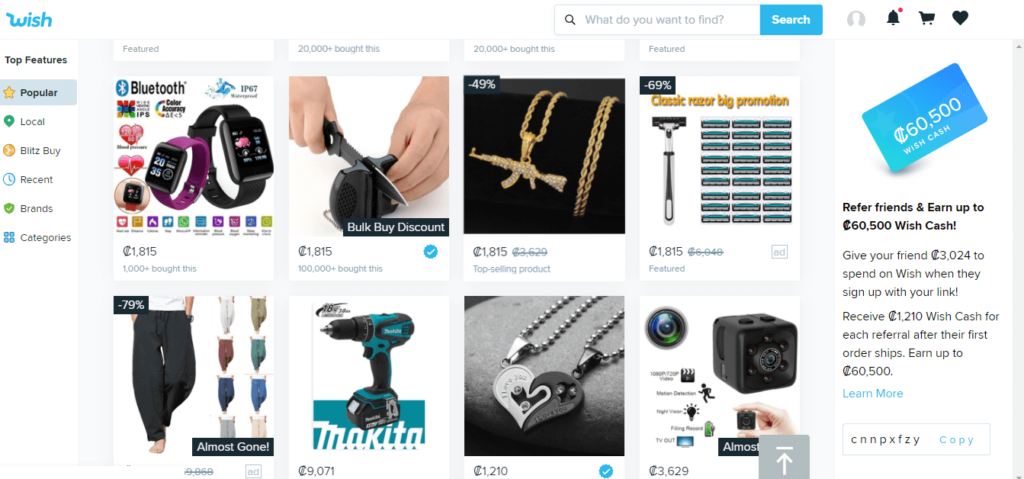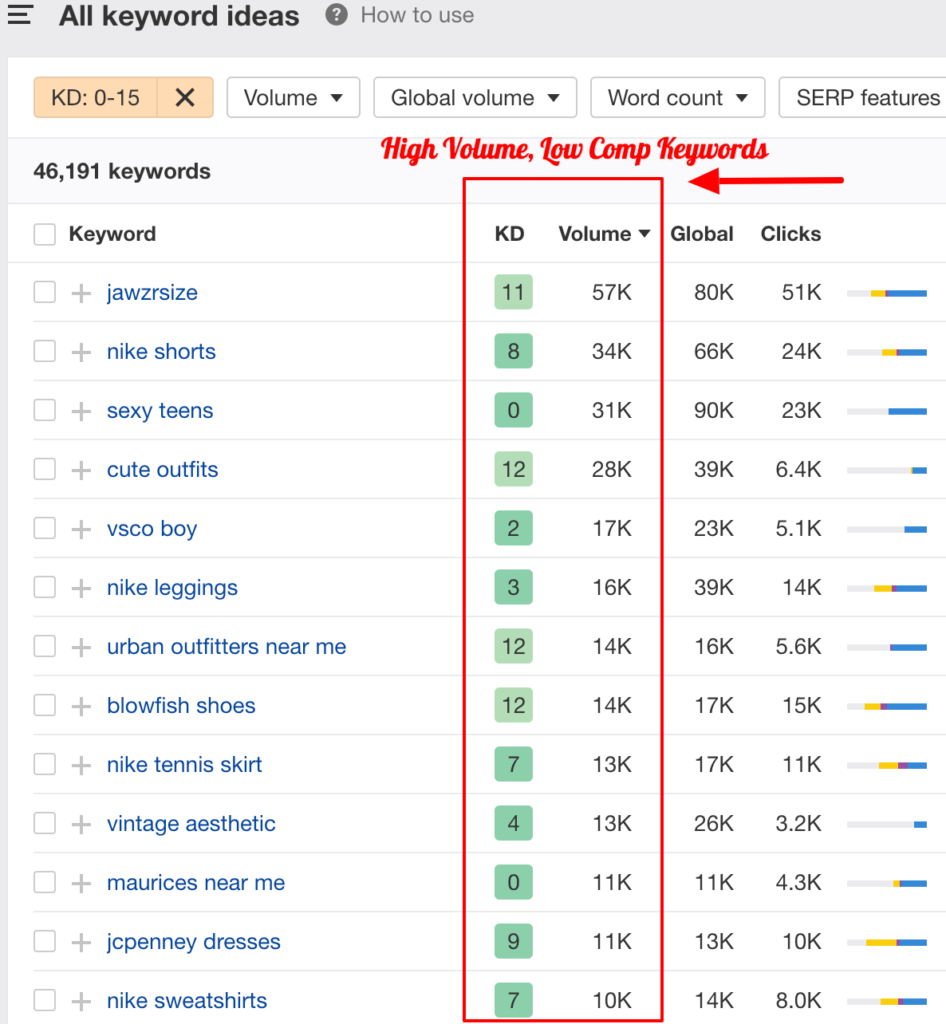
Table Of Contents
Are you desperately trying to increase the revenue of your eCommerce business?
If so, you’re in the right place; this article will give you everything you need in terms of eCommerce SEO to build a successful online store!
I’m gonna tell you the best ways of getting targeted visitors to your shopping site.
Why Does Your Ecommerce Store Need SEO?
If any business is going to survive online, then they all need one thing in place, and that’s a bulletproof SEO strategy.
Without it, there’s a good chance your business will fail. And here’s the thing:
Having a successful eCommerce business isn’t always about having the best products; look at sites like Etsy or Wish.

They don’t have the best products; in fact, some of them are downright weird. But it’s their ability to attract customers, which sets them apart.
And they couldn’t do this without having an SEO strategy.
So, why do you need to use eCommerce SEO?
Well, quite simply, if you aren’t, you’re going to fall behind; because there’s one thing you can bet on, and that’s that your competitors will be using SEO.
The more organic traffic you can draw to your store, the more chance of converting traffic into paying customers. Now obviously, it’s not all down to traffic, but it’s a huge factor.
Let’s say you’ve chosen a keyword that has the traffic potential of around 5,000 visitors per month.
Even if we low ball the conversion rate at 3.5%, that would still equate to around 175 extra visitors a month. And depending on the cost of the item, that could make a huge contrast to your yearly income.
And that’s where the power of eCommerce SEO really comes in. One correctly chosen keyword can make all the difference to your yearly income.
Surely by now, you’re dying to learn the secrets of SEO success, so keep reading to find out the four stages for a perfect eCommerce SEO strategy and make sure to use use the WordPress CMS for your online store website.
The 4 Stages Of Ecommerce SEO
As mentioned earlier, to boost your eCommerce store is to implement these four SEO steps.
By carrying out each stage, you have the best chance of pushing your eCommerce store to the next level.
The most important thing is to do them in the right order and take your time to ensure each stage is done properly.
1. Audit Your Site
The first step to achieving perfectly executed eCommerce SEO is to audit the store and determine where the current problems lie.
These could be things like:
- Technical issues, i.e., cannibalization
- Site structure difficult for search engines to crawl
- No content
Unlike popular belief, link building doesn’t fix every SEO problem. The first thing you should focus on is a full and in-depth site audit.
But how?
There are a couple of SEO tools that can be used for eCommerce store audits like:
- Ahrefs
- SEMRush
But these tools come with a cost, so if you haven’t already got them, you can use the free tools for site auditing.
This section will focus on using Screaming Frog; the tool is free for up to 500 URLs, which is enough for most eCommerce businesses.
Open the Screaming Frog program, enter your URL into the search bar, and press “Start” to begin the crawl.

Once the crawl has finished, you can export the information. Here’s a top tip, when you export the data use the HTML filter to remove unimportant information.

Now you have all the data you need to perform the store’s audit, here’s what you’re looking for:
Find Your Missing Canonical Tags
This is a prevalent problem among eCommerce stores for a page to have multiple URLs that point to the content.
But this causes duplication issues, which then cause problems for your store. You can see what Google webmasters define as a canonical URL in the image below:

You can use Screaming Frog to help your find canonical tags by using the data in your crawl.
Click on the URL tab; move the screen to the right, and it will reveal the “Canonical Link Element 1” column.

If any of the spaces are empty, it means they have no canonical URL tag for that page, which means it’s more than likely duplicated itself.
Work your way through the list and ensure each one associates with one URL.
Missing Meta Description
In all honesty, having a highly optimized meta description won’t improve your rankings that much, but it’s still something you need to consider.
You see, a well-crafted meta description will help increase the click-through rate of your site, which helps pull in extra traffic.
To find missing metadata in the “Meta Description” tab, filter the results using the “Missing” and then export the data, repeat the for the “Duplicate” filter.

For any results that come back missing or duplicated, you need to either add a description or make it unique.
These are just a few of the things you can audit using Screaming Frog, but it’s not limited to these things. If you take a look at this post by Matthew Woodward, you can see it can also do things like:
- Find duplicate content
- Find 404 errors
- Find 302 redirects
- Find deindexed pages
- Find missing alt tags
Make sure you completely fix every issue found by your store audit. It’s your best chance of success.
2. Keyword Research
Keyword research should always be one of the most important things; as mentioned before, one keyword can be life-changing.
Most people will pick a keyword-based on the traffic it brings to the site, which isn’t always the best way to do things.
Because of this, they fall into one of the many pitfalls site owners need to dodge. This section is going to show you the four things your keywords need to bring you success.
Keyword research for eCommerce stores works slightly differently than usual, so make sure you pay attention:
Make Sure It’s Relevant
The keyword should be appropriate to the product you’re selling if you want to attract customers. If the keyword is relevant to what you’re offering, you’ll increase your conversion rate.
Finding relevant keywords is pretty straightforward and is a simple case of using the computer between your ears.
Let’s say your eCommerce store sells shoes; it would be safe to say a keyword for men’s t-shirts isn’t going to be relevant to your store.
The easiest way to see if a keyword is relevant to your store is by googling it. If the top results are similar to your store, it’s safe to say the keyword is relevant to you.
Make Sure The Keyword Has The Right Intent
If your keyword doesn’t have the right intent, then it won’t drive people in at the right stage of the sales funnel. How much traffic the keyword brings is irrelevant unless it has the right intent.
A general rule of thumb is people at the lower stages of the funnel tend to be more ready to buy, but there are fewer of them.
So, how do you know what keywords to use?
As mentioned before, it’s all about understanding what stage of the sales funnel you want to attract your customers from.
The list below will include phrases that should be included in the keyword to attract people to the kind of traffic suited to your business:
Stage 1: Awareness Keywords
- List of
- Definition
- Why
- What is
Stage 2: Interest Keywords
- Guide
- Brand name
- How to
- Tutorial
Stage 3: Evaluation Keywords
- Price
- Best
- Top 10
- Cheap
Stage 4: Purchase Keywords
- Buy now
- Discount
- Deal
- Free shipping
If you keep the above list in mind when picking your keywords, they will have the right intent to pull in customers; you’ll also notice a boost in your conversion rates.
It Has A Good Search Volume
It’s all well and good having the perfect keyword, but if no one searches for the keyword, it will not benefit you.
What counts as a high search volume for a keyword will vary between niches, so it’s up to you to do some research and find out.
Just don’t pick the keyword solely based on the traffic it brings; make sure you consider all four things. Sometimes mid traffic keywords will bring you more bang for your buck.
Make Sure You Can Compete
If the keyword you’re trying to rank for has a lot of competition, it’s unlikely your new store will be able to rank for it. You won’t have the page authority needed to compete… yet.
That’s why you have to pick keywords you could realistically compete for.
Try to target words with low competition and high search volume until you’ve built up your store’s authority.
I have used the AHREFs SEO tool and found these high-volume, low-competitive keywords!

3. On-Page SEO
Every online business needs to implement on-page SEO if they want to succeed. After fixing any technical problems with the first stage, on-page SEO builds the next layer of foundations for your online store.
In essence, it’s about making it easier for Google to understand your page while making it user-friendly for your customer.
Here are some of the things to take care of to ensure your on-page SEO is perfect:
Meta Description – Should have additional keywords and offer an honest description of what the page is about.
Headings – Make sure you use the right headings with a mixture of keywords. Each page should have one set of H1 tags followed by H2, H3, etc.
Product Description – Make sure you write unique product descriptions, do not copy and paste them—top tip focus on the benefits, not the features.
Title Tags – The title should include the primary keyword as close to the start as possible.
Internal Links – This underused tactic will help people navigate around your store, but it also helps Google crawl your site and find new content. You should learn how to do internal linking to boost organic traffic.
Images – All the images should be high-quality and have a file name and alt tag that matches the product; it could even include a keyword.
By using the above techniques, you quickly fix any on-page SEO issues whilst boosting your pages in the SERPs. The best thing is it’s completely free to do and only takes a few minute’s works to put right.
4. Link Building
Unlike popular belief, this should be your last tactic to increase your store’s visibility. You see, without all the other things in place, it’s unlikely that your link-building efforts will take hold.
There are loads of link building strategies out there you can use to grow your business. But today will focus on the strategies that have the best ROI:
Guest Posting
Yes, this is one of the most popular link-building strategies, but it works for a good reason!
Guest posting helps you do three things:
- Build a relationship
- Get a link
- Gain exposure
And it’s these three things that make it such a popular tactic, especially when you consider how easy it is to do.
All you need to do is follow these four simple steps:
Find Some Targets
You can do this by using Google; search for your keyword with the following phrases:

If anything looks like a match, add it to an Excel sheet; keep doing this until you have a solid list of targets.
Qualify Your Targets
This is about making sure the targets are worth building a link from. You’re searching for websites that have high domain authority and receive a lot of traffic.
You can check this out using Ahrefs or SEMRush. For any target that doesn’t cut, delete it from your list.
Outreach
Now it’s time for outreach; you can create an awesome pitch, make sure it’s personal, and adds value to the website.
If they don’t message back the first time, make sure you send a follow-up, you’ll be surprised how many responses you get on the second or third email.
Write The Content
You can start writing the content once everything has been agreed upon (topic, pricing, writing guidelines). Don’t forget to add a link to your page and sprinkle some internal links to their pages.
Rounding Up
You know why eCommerce SEO is important for any online store to become successful and compete in the market.
By following the steps above, you can increase the amount of organic traffic your store generates, and not only that, but you will attract qualified customers that convert.

Thank you for sharing this informative post. This article is very helpful for my new e-commerce website. Keep posting
Running an audit on your website is probably one of the most essential factors of running a successful online business. This tells you where your business stands in terms of website health. This could also be helpful in showing you what you could improve on and what you have been doing that’s been working.
its a well detailed blog post, good for a fresher.
It was descriptive and to the point information. Nicely covered all the necessary factors for e-commerce SEO. It will be very helpful for beginners to understand all insights of e-commerce SEO. It is always a good practice to complete the basic prerequisites before you start with any strategies.